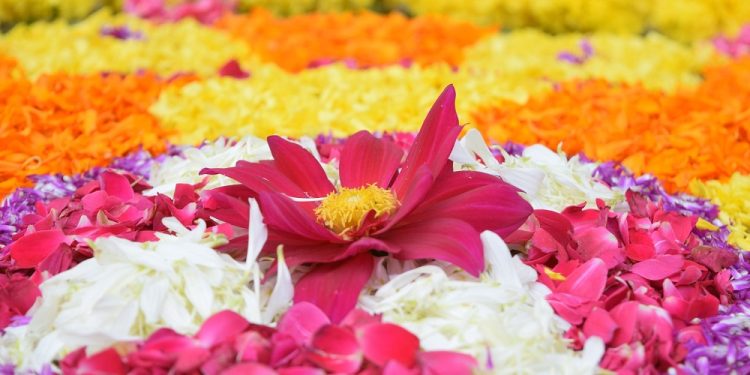
Onam
Celebrated by the Malayali, Onam is a Hindu festival that is celebrated on the Thiruvonam Nakshatra in the month of Chingam—which falls approximately on a date between August and September on the Gregorian Calendar. The date of this holiday is based on the Hindu calendar and almanac known as Panchangam.
It is a harvest festival mainly celebrated in Kerala, India, but is celebrated by many Hindus all over the world—particularly among the Malayali people. Folklore attributes the celebration of this holiday to the commemoration of King Mahabali.
It’s said that King Mahabali’s soul visits Kerala during Onam. This holiday is one of the three major harvest festivals in the Hindu religion—with the other two being Thiruvathira and Vishu.
This holiday is observed in several different ways, but usually, the celebrations include boat races (Vallam Kali), tiger dances (Pulikali), tug of war events, mask dances (Kummattikali), martial arts events, offerings of plantains, and music.
The History of Onam
According to historians, Onam is a holiday that has a long history in Kerala and other parts of Southern India. One of the earliest references to this holiday is found in the Maturaikkāñci—an ancient Tamil poem that was written during the Classical Period, sometime between the 2nd and 4th century CE.
In this poem, there is a mention of Onam being observed and embraced in various Madurai temples. During these celebrations, people put on their finest clothing and feasted, gifts to the gods were presented, and many duels and games were held.
Onam would again be mentioned in Pathikas and Pallads by Periyazhvar during the 9th century, and that account mentions several community celebrations, feasts, and offerings to Vishnu. It has been mentioned ever since in various pieces of literature.
In the 16th century, a European memoir gives an account of Onam, although it does get some things wrong. For example, the memoir states that the holiday is always celebrated in September, which isn’t true because sometimes the holiday begins during August on the Gregorian calendar.
The Legend Behind Onam
Since Onam is tied to ancient Hindu festivals in Southern India that celebrated the rice harvest, it has its basis in several Hindu folklore tales. One of these legends is the most common, so we decided to briefly recap it so everyone learning about this holiday will have a better understanding of it.
The Legend of Mahabali
In Hindu mythology, Mahabali (also known as Maveli and Bali) is a Daitya king who was the great-great-grandson of Kashyapa—a Brahmin sage. Kashyapa was the great-grandson of Hiranyakashipu, a dictator of demonic blood, and the grandson of Prahlada, a devotee of Vishnu.
In this story, Prahlada rebels against his father’s persecution of the people and decides to worship Vishnu. As a result, Hiranyakashipu tries to kill Prahlada but is instead slain by Vishnu, who defeated him while in his Narasimha avatar.
This results in Prahlada being saved. Mahabali, Prahlada’s grandson, would come to power by defeating the Devas and taking over all three worlds. The defeated Devas would then approach Vishnu for help against Mahabali, but Vishnu refused their pleas because he felt that Mahabali was a good king and a devoted disciple.
After Mahabali defeated the gods, he declared that he would perform sacred fire rituals known as Yajna to grant the request of anyone who asks for one. Vishnu would take the form of an avatar of a dwarf monk called Vamana and decided to go talk to Mahabali.
The king offered gold, cows, elephants, and other valuables to the boy, and the boy replied that all that was needed was three paces of land. After Mahabali agreed, Vamana grew to giant size and covered everything that the king ruled over in just two paces.
For the third and final pace, Mahabali offered his head for Vishnu to step on, and this allowed Vishnu to see that Mahabali was truly a devoted disciple. Vishnu would then grant him a boon.
This boon allowed him to visit the people and the lands that he had previously ruled once per year. This time is then marked by the Festival of Onam—a reminder of the virtuous rule of Mahabali and his humility in keeping his promises before Vishnu.
Customs & Celebrations of Onam
The Festival of Onam starts on the day of Atham and ends on the day of Thiruvonam, thereby lasting a period of about ten days. During this carnival, flowered carpets called Pookalam are laid in front of every household.
This is often followed by fireworks, parades of elephants, and an elaborate feast called Sadhya. This feast is generally composed of traditional vegetarian dishes that are served on banana leaves.
Another event featured during this festival is the Vallamkali—or snake boat race. The festival is also accompanied by a lot of music and dancing, particularly tiger dances known as Pulikali.








